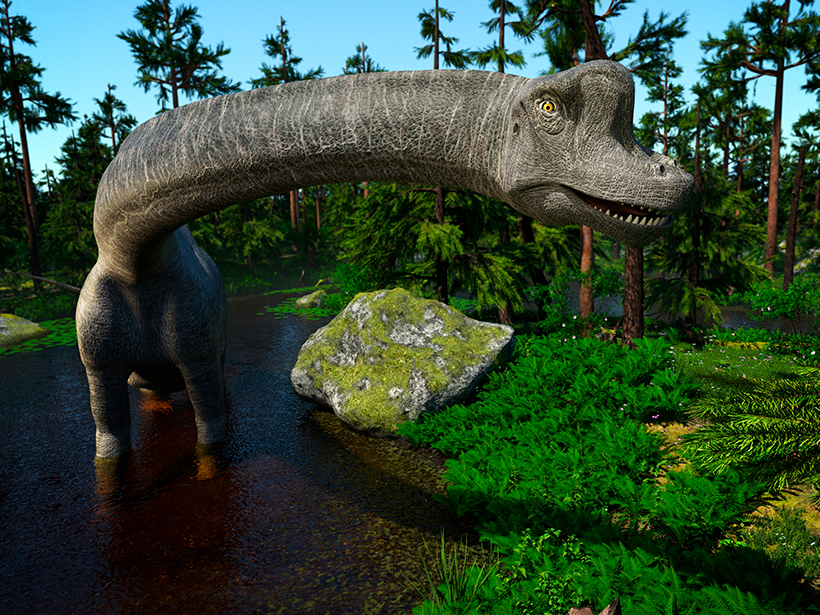Carnivorous dinosaurs may get all the attention, but their plant-eating kin likely played an important role in boosting ecosystem health by distributing nutrients, a new study shows.
That role involves their poop. Christopher Doughty, an environmental scientist at Northern Arizona University in Flagstaff, has investigated the long-held hypothesis that large herbivores—brachiosaurs, triceratops, and the like—transported nutrients by defecating significant distances from where they ingested their food.
“By redistributing elements, herbivores were making the whole ecosystem more productive.”
Doughty compared hundreds of coal deposits from the herbivore-rich Cretaceous period with coal samples from the older Pennsylvanian subperiod, which lacked four-legged large herbivores. His analysis showed that coals from the Cretaceous have significantly higher levels of nutrients than the Pennsylvanian subperiod coals.
The finding, published earlier this month in Nature Ecology and Evolution, suggests that the many herbivorous dinosaurs alive during the Cretaceous period were effective at spreading plant-important nutrients far and wide. “By redistributing these elements, herbivores were making the whole ecosystem more productive,” Doughty said.
From Dung to Coal
Large animals produce a lot of dung, but that’s not really why they’re good at distributing nutrients, said Doughty. “The key is that large animals move these elements across landscapes.”
An herbivore living during the Cretaceous walked between 7 and 16 kilometers between eating a meal and defecating.
By making assumptions about dinosaur movements, feeding patterns, and biology—based on the attributes of large modern-day mammals—Doughty estimated that an herbivore living during the Cretaceous walked between 7 and 16 kilometers between eating a meal and defecating. That’s a long way, he said, far enough for an animal to travel away from the presumably nutrient-rich area in which it consumed its food and into a potentially nutrient poor area.
If these estimations reflect truth, Doughty reasoned, records of plant material from time periods with many large herbivores ought to be more enriched in nutrients—and more evenly so—than records from eras lacking large herbivores. That’s simply because plants growing in ecosystems with higher levels of nutrients tend to take those nutrients into their tissues.
But where could he find past records of plant material? The answer, Doughty realized, lay with coal: Over time, buried plant material forms peat and then coal. This coal could reveal clues about behaviors of defecating dinosaurs, Doughty figured.
Thousands of Coal Samples
Doughty used an online database called COALQUAL maintained by the U.S. Geological Survey to extract chemical measurements from more than 600 Cretaceous era coal deposits and nearly 5,000 Pennsylvanian subperiod coal deposits, distributed in the western United States and in the Appalachian region, respectively. His analysis showed that levels of calcium, magnesium, phosphorus, and sulfur were significantly higher—by 136%, on average—and less variable in the Cretaceous coals than the Pennsylvanian subperiod coals.
To check that weathering processes like erosion and precipitation weren’t causing the discrepancy, Doughty extracted data about aluminum, an element toxic to plants and therefore not incorporated into their issues, from COALQUAL. The difference in aluminum concentration between the Cretaceous and Pennsylvanian subperiod coal samples was small and not statistically significant, which suggests that a change in weathering patterns can’t explain the difference in nutrient levels.
Poop from trekking dinosaurs served both to enrich plant material and to equalize nutrients across plant communities.
Doughty concluded that the heightened and steadier levels of plant-important nutrients in the Cretaceous period coals were due to plant material being dispersed by dinosaur poop.
In other words, the poop from trekking dinosaurs served both to enrich plant material and to equalize nutrients across plant communities represented by the coal seams. In this way, nutrient-poor areas likely gained minerals needed to sustain healthy ecosystems, Doughty explained.
Innate differences in nutrient uptake among plants living during the two time periods might call into question this hypothesis, Doughty acknowledged. But recent research has found that the types of plants common in the Pennsylvanian subperiod contained higher levels of calcium, magnesium, and phosphorus than plants widespread in the Cretaceous. That finding suggests that herbivorous dinosaurs might have had an even larger effect than originally estimated, Doughty noted.
Loads to Digest
“Large herbivores are critical for changing the large-scale distribution of nutrients.”
This work “strongly suggests that large herbivores are critical for changing the large-scale distribution of nutrients,” said Hillary Young, an ecologist at the University of California, Santa Barbara, who was not involved in the research.
But the modern era—the Anthropocene, literally, the “age of man”—simply doesn’t have a lot of large, free-roaming animals left to distribute nutrients, Doughty explained. So if we lose these animals, like hippos and elephants, ecosystems could suffer for a very long time, he added.
“Large animals are playing a critical role in ecosystems that can’t be replicated in other ways,” Doughty said. “We need to start thinking about preserving ecosystems with large animals.”
—Katherine Kornei (email: [email protected]; @katherinekornei), Freelance Science Journalist
Citation:
Kornei, K. (2017), Signatures of dinosaur poop found in Cretaceous coal seams, Eos, 98, https://doi.org/10.1029/2017EO085735. Published on 31 October 2017.
Text © 2017. The authors. CC BY-NC-ND 3.0
Except where otherwise noted, images are subject to copyright. Any reuse without express permission from the copyright owner is prohibited.

